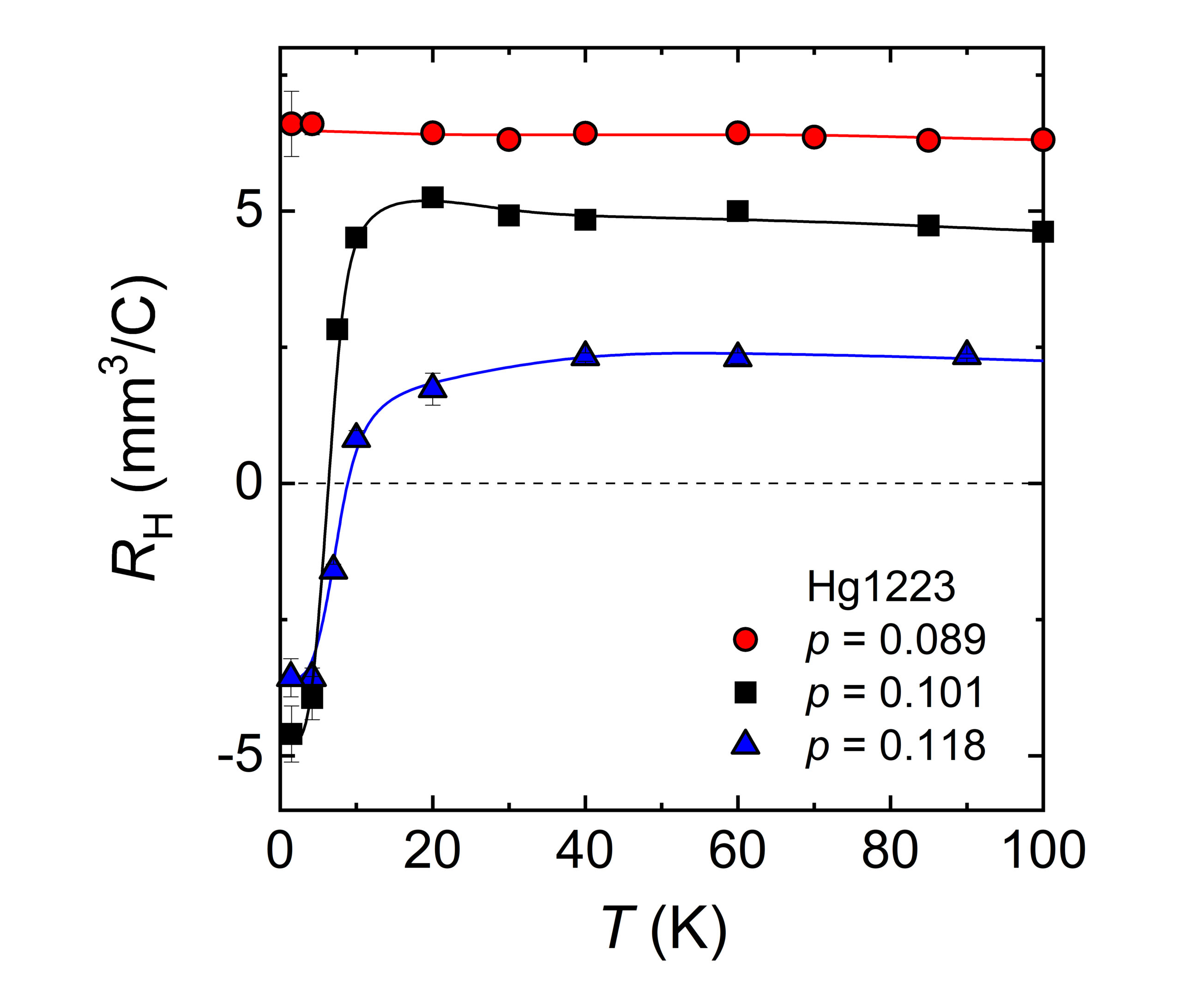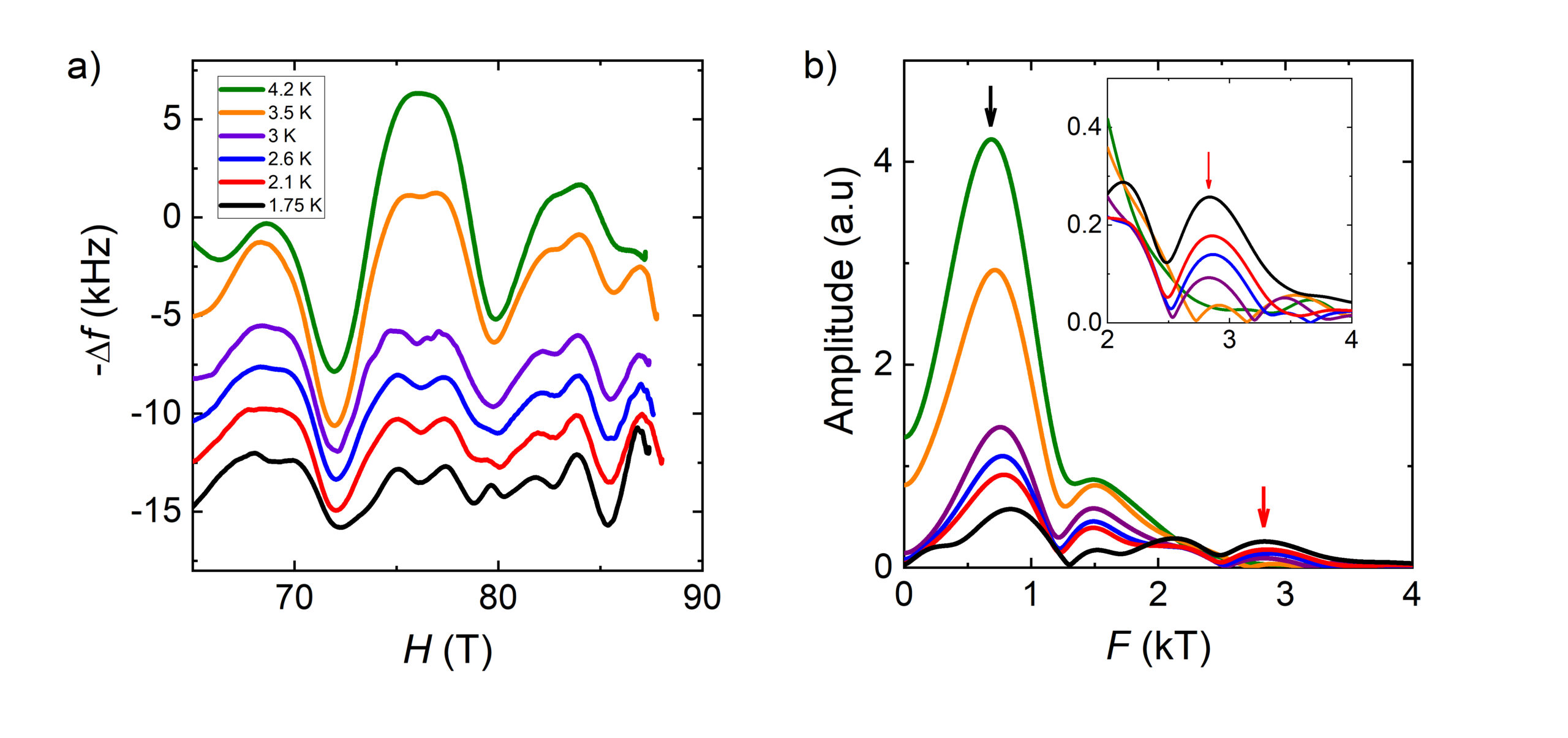V. Oliviero, D. Vignolles, C. Proust, LNCMI Toulouse, W. A. Atkinson, Trent University, Canada.
The ubiquity of the interplay between antiferromagnetic (AFM) order, charge density waves (CDWs), and superconductivity is a general feature of hole-doped cuprates. The role of AFM order is still strongly debated, although the pairing mechanism is widely accepted to be of magnetic origin. In a recent work, we studied the trilayer cuprate HgBa2Ca2Cu3O8+δ (Hg1223), in which the inner CuO2 plane is protected from out-of-plane disorder and, therefore, is extremely clean and free of distortions.
Figure 1 shows the evolution of the Hall coefficient (at 85 T). For hole doping of p = 0.118 and p = 0.101, there is a sudden sign change of the Hall coefficient below about 10 K that is not observed at lower doping. In YBCO, this sign change has been attributed to a small closed electron pocket coming from a Fermi-surface reconstruction by charge order. Here, the abruptness of the transition and its low temperature are surprising. We were able to track the Fermisurface morphology through the transition using quantum-oscillation measurements. Figure 2a shows the evolution of the quantum oscillations at different temperatures for p = 0.112. At 4.2 K, there is a strong low-frequency oscillation, whose amplitude decreases with decreasing temperature. At 1.75 K, those oscillations are weaker and small-amplitude oscillations at higher frequencies have emerged. This is inconsistent with the Lifshitz–Kosevich theory and signals a Fermi-surface reconstruction. The temperature evolution of the oscillation spectrum is visible in the Fourier analysis of the oscillatory part of the data (figure 2b).
To gain more insight on this sudden change of the Hall effect and quantum-oscillation spectrum evolution, we numerically simulated quantum oscillations of the density of states. These calculations point to a Fermi-surface reconstruction in the inner plane from an AFM state (hole pockets) to a biaxial CDW (electron pocket). A remarkable implication of our work is that AFM and CDW compete because they share the same Fermi-surface “hot spots”. This coincidence is a key feature of a spin-fermion model, in which charge order is mediated by critical spin fluctuations and which supports magnetically mediated pairing interaction in cuprates.

Figure 1: Temperature dependence of the normal-state Hall coefficient RH, measured at 85 T in Hg1223 for p = 0.089, p = 0.101, and p = 0.118. At p = 0.101 and p = 0.118, RH changes sign abruptly below 10 K, while it remains positive down to the lowest temperature for p = 0.089.

Figure 2: (a) Quantum-oscillatory signal (TDO) for p = 0.112. (b) Discrete Fourier analysis of the oscillatory signal shown in panel (a) between 70 and 87 T. The black (red) arrow marks the low (high) frequency observed at 4.2 K (1.8 K). The broadening of the Fourier transform at low frequency comes from the small number of oscillations in the field range. The inset shows a zoom of the Fourier transform between 2 and 4 kT, where one can clearly see the emergence of two peaks at F = 2100 T and F = 2800 T (red arrow).
Charge order near the antiferromagnetic quantum critical point in the trilayer high Tc cuprate HgBa2Ca2Cu3O8+δ, V. Oliviero, I. Gilmutdinov, D. Vignolles, S. Benhabib, N. Bruyant, A. Forget, D. Colson, W. A. Atkinson and C. Proust, npj Quantum Materials 9, 75 (2024).
https://www.nature.com/articles/s41535-024-00688-6
Contact: cyril.proust@lncmi.cnrs.fr, david.vignolles@lncmi.cnrs.fr






